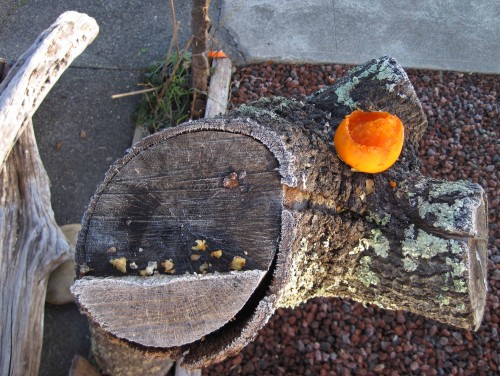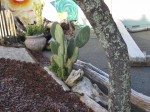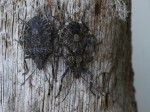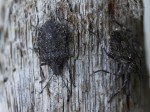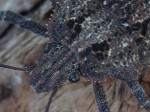
Garden Log (what I did):
1. Cold here in Sebastopol, California — well at least for us — with the growing season nearly dormant. We finally got some garlic starts in the ground about a month ago in the front veggie bed along the sidewalk. Maybe this week I’ll plant fava beans there to grow SOMETHING.
2. Harvested hachiya persimmons from a neighbor’s tree.
3. Inspected Salamander Swimhole’s vitality.
4. Discovered brown marmorated stink bugs on a piece of driftwood in the front garden.
You, the Habitat Gardener (reflections):
1. Our garlic crop in the front bed will be ready next late spring, just in time for us to plant sunflowers. We get garlic; the critters will reap the sunflowers.
2. The persimmon that was left on Oak Pedestal last night is half eaten. A long deck screw holds the persimmon in place and secure from strong critters, like a squirrel, that might want to eat the persimmon elsewhere. The long screw’s head was snipped off, then that end was impaled into the oak limb’s crotch, leaving the pointy end of the screw skyward.
So easy to screw an apple, a persimmon, a tough piece of food onto the screw and thwart thieving critters. Ha!, I am smarter for once.
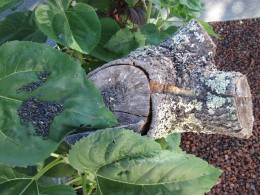
Top view of Oak Pedestal feeder surrounded by a summer crop of sunflower. The black oiled sunflower seeds are bagged birdseed. How fun to place some seeds on the sunflower leaf platters. Note the up-ended deck screw (in the oak limb crotch), which is used to secure apples and other food offerings.
3.Salamander Swimhole, which seemed a lost cause because of foul water (see my November 27, 2010 entry: http://sporelore.com/residential-habitats/garden-pond/) is clearing. The magnolia tree’s leaves have all fallen for a month now so the pond is no longer being overwhelmed with fresh organic matter. Algae is growing faster now that more sunlight is reaching the pond; the magnolia leaves were shading the new pond water. Just-visible microbes are whirling about in the water and the potted plants are showing new growth. The pond will thrive, with luck in time for a pacific tree frog to want to lay eggs in it this spring.
4. Brown marmorated stink bugs ( Halyomorpha halys) are in the insect family Pentatomidae and are known as an agricultural pest in their native range of China, Japan, Korea and Taiwan. Yes, they are not native to our California soil. But they are so cool! Given the species’ alien trait, I’d rather they didn’t exist in our garden BUT three bugs on one small piece of driftwood means there are probably many others entrenched in our neighborhood. What’s a sustainability-minded Master Habitat Landscaper Apprentice like me to do? Nothing, that’s what. Sure, I rather the garden be full of native insects to work the garden and provide food for higher tropic animals. But perhaps alien pollinators (or non-pollinators) will feed some of those higher tropic animals, i.e., animals more sophisticated/more developed. An insect meal might just be an insect meal to a hungry woodpecker during these food-is-sparse short days of winter.
A couple of cool facts about these alien-to-California brown marmorated stink bugs: a) They are actually bugs! “Bug” is often a lay term for “insect”, but “true bugs” are only one order of insect, like “beetle” is another order of insect. b) Stink bugs get their name from a smelly fluid emitted from their thorax when threatened. I was lucky to get the bugs pictured (below) without getting sprayed — surely their sluggishness from the cold was in my favor. c) The term “marmorated” is derived from Latin for “marbled”. Close inspection of the seemingly “brown”/dull-looking wing tips and exoskeleton’s back plates (pronotum, esculetum, elytron) reveals magnificent design and color. Sure wouldn’t want to be an ant when that steel-plated star cruiser crawls overhead.
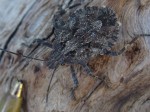
 Enjoy all things, stinky or not.
Enjoy all things, stinky or not.
Tony

